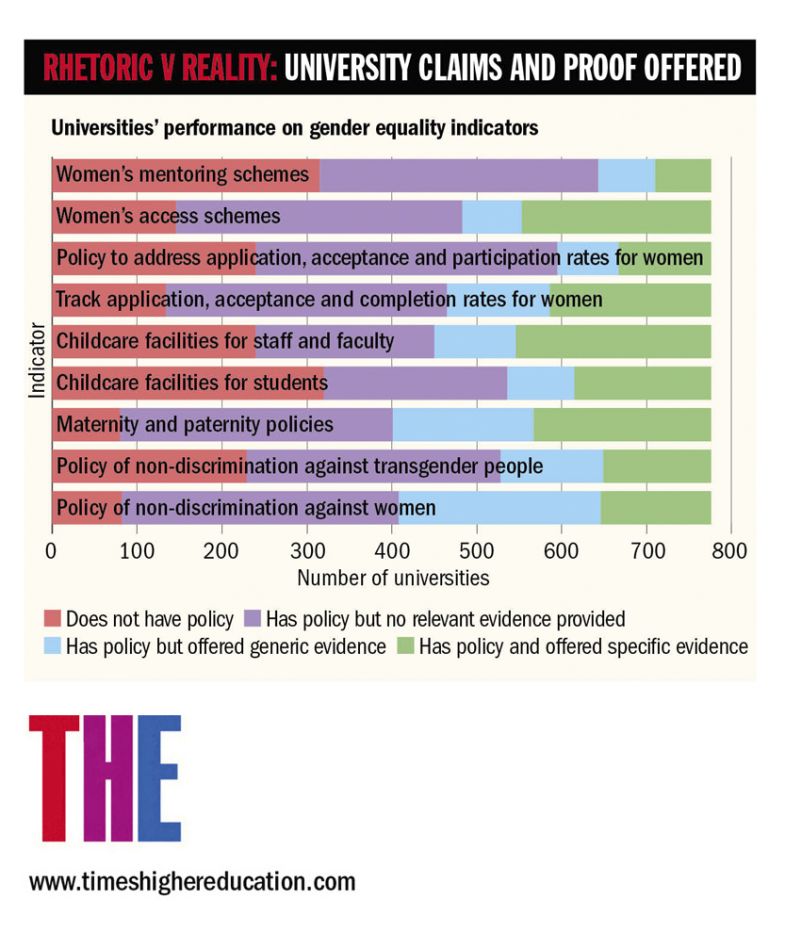点击免费下载一份泰晤士高等教育Unesco-IESALC性别平等报告
点击阅读英文原文
根据泰晤士高等教育一份关于高校促进性别平等进展的新报告,全球大部分高校无法提供其支持女性进步的政策和服务的信息。
全球有超过750所高校向最新的泰晤士高等教育大学影响力排名提交了与联合国可持续发展目标(SDG 5)相关的数据,这些数据侧重于促进性别平等,其中大多数高校声称拥有各种有助于实现该目标的政策和服务目标,例如反对歧视女性的政策和提升女性准入方案。
然而,能够提供此类举措相关证据大学的比例均低于50%。

参与该排名的高校被要求为12项性别平等指标提供证据。证据提交率最差的两项为是否存在针对在校学生的女性指导计划和女学生入学问题的政策。尽管分别有59%和69%的高校称正在开展此类活动,但仅有不到1/4(分别为17%和23%)提供了证据。即便是已提交的证据,其中大部分被认为是通用而非针对具体问题的证据。
支持文件提供率最高的为产假与育儿假政策和不歧视女性政策。分别有90%和89%的高校表示提供此类措施。但即使在这些领域,只有48%和47%的高校提供了相关证据(且仅有27%和17%提供的是针对具体问题的证据)。
THE Campus views: Boosting female representation in STEM is crucial to global innovation
该排名要求高校提供证据,部分是为了评估大学社区和公众是否能够在政策方面让高校对其承诺负责;而从服务的角度,要求证据旨在了解受众是否能轻松了解并使用高校所提供的内容。
总体而言,位于英语国家的高校往往更有可能提交证据——这些高校在75%的情况下提供了证据,而其他国家的这一比例为38%。
然而,这份与联合国教科文组织拉丁美洲和加勒比地区国际高等教育研究所(IESALC)合作于国际妇女节发表的报告发现,在哪些大学声称拥有某些政策和服务这一点上,也存在显著的地区差异。
各国差异最大的指标是不歧视跨性别者的政策。只有14%的伊拉克高校和17%的伊朗高校表示提供此类政策;而澳大利亚、意大利和英国高校的这一比例为100%。中东国家没有任何一所高校提交了此类政策的具体证据。
报告称,这反映了跨性别权利是“争取性别平等的新前沿,在一些国家才刚刚开始出现并且进展缓慢”。
其他的地区差异可能更令人惊讶。为学生提供托儿设施高校比例最低的是法国,仅为15%,而加拿大和澳大利亚高校的比例为100%。
总体而言,这份名为《性别平等:全球大学的表现如何》(Gender Equality: How global universities are performing)的报告发现,大洋洲高校在性别平等承诺方面的努力遥遥领先。
格罗宁根大学(University of Groningen)人力资源管理和组织行为系副教授苏珊娜·陶伯(Susanne Täuber)表示,该报告的调查结果反映了“政策与实践的差距”,这意味着虽然某些规范表面上已经到位,但它们通常尚未在全机构实施,或者它们被呈现为问题的“快速解决方案”,而不是全面的、可持续解决方案。她补充说,缺乏证据表明学生和教职工可能不知道存在一些与性别相关的政策和服务。
她说:“这是一个大问题,因为我们制定了所有政策,也制定了立法;但它只是没有以一种有凝聚力的方式实施。”
“一些女性会从一些政策中受益,例如她们的领导会提醒她们注意或使其实施。其他女性不会知道这些政策。”
剑桥大学丘吉尔学院院长阿西妮·唐纳德(Athene Donald)同意,如果大学未能提供证据,这表明这些政策没有得到实施。
她说:“我能想到很多例子,比如(大学里的)人说,‘我们不会容忍欺凌’。但是写在哪里呢?你将如何处理它?我认为这样的事物仍在编纂中。”
后记
Print headline: Universities tout gender equality efforts but offer scant evidence






